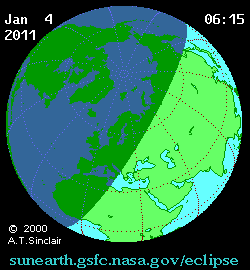Solar eclipse of January 4, 2011
| Solar eclipse of January 4, 2011 | |
|---|---|
 Partial from Poland | |
| Type of eclipse | |
| Nature | Partial |
| Gamma | 1.0627 |
| Magnitude | 0.8576 |
| Maximum eclipse | |
| Coordinates | 64°42′N 20°48′E / 64.7°N 20.8°E |
| Times (UTC) | |
| (P1) Partial begin | 6:40:11 |
| Greatest eclipse | 8:51:42 |
| (P4) Partial end | 11:00:52 |
| References | |
| Saros | 151 (14 of 72) |
| Catalog # (SE5000) | 9531 |
A partial solar eclipse occurred at the Moon’s ascending node of orbit on Tuesday, January 4, 2011,[1][2][3] with a magnitude of 0.8576. A solar eclipse occurs when the Moon passes between Earth and the Sun, thereby totally or partly obscuring the image of the Sun for a viewer on Earth. A partial solar eclipse occurs in the polar regions of the Earth when the center of the Moon's shadow misses the Earth.
This was the first of four partial solar eclipses in 2011, with the others occurring on June 1, July 1, and November 25.
The greatest eclipse occurred at 08:51 UTC in northern Sweden. At that time, the axis of the Moon's shadow passed a mere 510 km above Earth's surface.[4]
The eclipse was visible near sunrise over most of Europe before moving over central Asia. It ended at sunset over east Asia. It was visible as a minor partial eclipse over north Africa and the Middle East.
Visibility
[edit]Photo gallery
[edit]-
Slobozia, Romania at 7:52 UTC
-
Almería, Spain at 8:03 UTC
-
Avellino, Italy at 8:18 UTC
-
Ebersberg, Germany at 8:32 UTC
-
Composite image from Bernau am Chiemsee, Germany
-
Vienna, Austria at 8:34 UTC
-
Stockholm, Sweden at 8:36 UTC
-
Marki, Poland at 8:38 UTC
-
Progression from Katowice, Poland
-
Petrov nad Desnou, Czech Republic at 8:41 UTC
-
Bratislava, Slovakia at 8:43 UTC
-
Tomsk, Russia at 8:44 UTC
-
Video from Moscow, Russia
-
Sana'a, Yemen at 8:47 UTC
-
From Moscow, Russia at 9:02 UTC.
-
Eclipse and Airbus A319 in Moscow Oblast at 9:05 UTC
-
Kirkcaldy, Scotland at 9:14 UTC
-
Haarlem, Netherlands, 9:29 UTC
Eclipse details
[edit]Shown below are two tables displaying details about this particular solar eclipse. The first table outlines times at which the moon's penumbra or umbra attains the specific parameter, and the second table describes various other parameters pertaining to this eclipse.[5]
| Event | Time (UTC) |
|---|---|
| First Penumbral External Contact | 2011 January 04 at 06:41:18.7 UTC |
| Greatest Eclipse | 2011 January 04 at 08:51:42.4 UTC |
| Ecliptic Conjunction | 2011 January 04 at 09:03:43.1 UTC |
| Equatorial Conjunction | 2011 January 04 at 09:16:20.6 UTC |
| Last Penumbral External Contact | 2011 January 04 at 11:02:01.4 UTC |
| Parameter | Value |
|---|---|
| Eclipse Magnitude | 0.85759 |
| Eclipse Obscuration | 0.79839 |
| Gamma | 1.06265 |
| Sun Right Ascension | 18h59m14.9s |
| Sun Declination | -22°44'21.1" |
| Sun Semi-Diameter | 16'15.9" |
| Sun Equatorial Horizontal Parallax | 08.9" |
| Moon Right Ascension | 18h58m23.8s |
| Moon Declination | -21°46'01.2" |
| Moon Semi-Diameter | 15'18.1" |
| Moon Equatorial Horizontal Parallax | 0°56'09.6" |
| ΔT | 66.3 s |
Eclipse season
[edit]This eclipse is part of an eclipse season, a period, roughly every six months, when eclipses occur. Only two (or occasionally three) eclipse seasons occur each year, and each season lasts about 35 days and repeats just short of six months (173 days) later; thus two full eclipse seasons always occur each year. Either two or three eclipses happen each eclipse season. In the sequence below, each eclipse is separated by a fortnight.
| December 21 Descending node (full moon) |
January 4 Ascending node (new moon) |
|---|---|
 |

|
| Total lunar eclipse Lunar Saros 125 |
Partial solar eclipse Solar Saros 151 |
Related eclipses
[edit]Eclipses in 2011
[edit]- A partial solar eclipse on January 4.
- A partial solar eclipse on June 1.
- A total lunar eclipse on June 15.
- A partial solar eclipse on July 1.
- A partial solar eclipse on November 25.
- A total lunar eclipse on December 10.
Metonic
[edit]- Preceded by: Solar eclipse of March 19, 2007
- Followed by: Solar eclipse of October 23, 2014
Tzolkinex
[edit]- Preceded by: Solar eclipse of November 23, 2003
- Followed by: Solar eclipse of February 15, 2018
Half-Saros
[edit]- Preceded by: Lunar eclipse of December 30, 2001
- Followed by: Lunar eclipse of January 10, 2020
Tritos
[edit]- Preceded by: Solar eclipse of February 5, 2000
- Followed by: Solar eclipse of December 4, 2021
Solar Saros 151
[edit]- Preceded by: Solar eclipse of December 24, 1992
- Followed by: Solar eclipse of January 14, 2029
Inex
[edit]- Preceded by: Solar eclipse of January 25, 1982
- Followed by: Solar eclipse of December 15, 2039
Triad
[edit]- Preceded by: Solar eclipse of March 5, 1924
- Followed by: Solar eclipse of November 4, 2097
Solar eclipses of 2008–2011
[edit]This eclipse is a member of a semester series. An eclipse in a semester series of solar eclipses repeats approximately every 177 days and 4 hours (a semester) at alternating nodes of the Moon's orbit.[6]
The partial solar eclipses on June 1, 2011 and November 25, 2011 occur in the next lunar year eclipse set.
| Solar eclipse series sets from 2008 to 2011 | ||||||
|---|---|---|---|---|---|---|
| Ascending node | Descending node | |||||
| Saros | Map | Gamma | Saros | Map | Gamma | |
121 Partial in Christchurch, New Zealand |
February 7, 2008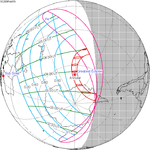 Annular |
−0.95701 | 126 Totality in Kumul, Xinjiang, China |
August 1, 2008 Total |
0.83070 | |
131 Annularity in Palangka Raya, Indonesia |
January 26, 2009 Annular |
−0.28197 | 136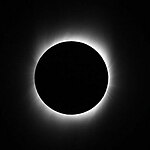 Totality in Kurigram District, Bangladesh |
July 22, 2009 Total |
0.06977 | |
141 Annularity in Jinan, Shandong, China |
January 15, 2010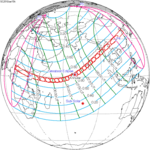 Annular |
0.40016 | 146 Totality in Hao, French Polynesia |
July 11, 2010 Total |
−0.67877 | |
151 Partial in Poland |
January 4, 2011 Partial |
1.06265 | 156 | July 1, 2011 Partial |
−1.49171 | |
Saros 151
[edit]This eclipse is a part of Saros series 151, repeating every 18 years, 11 days, and containing 72 events. The series started with a partial solar eclipse on August 14, 1776. It contains annular eclipses from February 28, 2101 through April 23, 2191; a hybrid eclipse on May 5, 2209; and total eclipses from May 16, 2227 through July 6, 2912. The series ends at member 72 as a partial eclipse on October 1, 3056. Its eclipses are tabulated in three columns; every third eclipse in the same column is one exeligmos apart, so they all cast shadows over approximately the same parts of the Earth.
The longest duration of annularity will be produced by member 19 at 2 minutes, 44 seconds on February 28, 2101, and the longest duration of totality will be produced by member 60 at 5 minutes, 41 seconds on May 22, 2840. All eclipses in this series occur at the Moon’s ascending node of orbit.[7]
| Series members 3–24 occur between 1801 and 2200: | ||
|---|---|---|
| 3 | 4 | 5 |
 September 5, 1812 |
 September 17, 1830 |
 September 27, 1848 |
| 6 | 7 | 8 |
 October 8, 1866 |
 October 19, 1884 |
 October 31, 1902 |
| 9 | 10 | 11 |
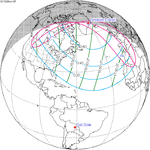 November 10, 1920 |
 November 21, 1938 |
 December 2, 1956 |
| 12 | 13 | 14 |
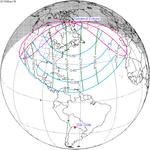 December 13, 1974 |
 December 24, 1992 |
 January 4, 2011 |
| 15 | 16 | 17 |
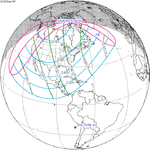 January 14, 2029 |
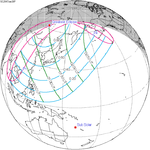 January 26, 2047 |
 February 5, 2065 |
| 18 | 19 | 20 |
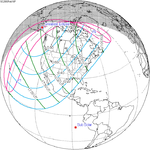 February 16, 2083 |
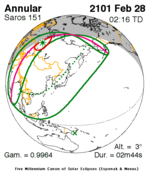 February 28, 2101 |
 March 11, 2119 |
| 21 | 22 | 23 |
 March 21, 2137 |
 April 2, 2155 |
 April 12, 2173 |
| 24 | ||
 April 23, 2191 | ||
Metonic series
[edit]The metonic series repeats eclipses every 19 years (6939.69 days), lasting about 5 cycles. Eclipses occur in nearly the same calendar date. In addition, the octon subseries repeats 1/5 of that or every 3.8 years (1387.94 days). All eclipses in this table occur at the Moon's ascending node.
| 22 eclipse events between January 5, 1935 and August 11, 2018 | ||||
|---|---|---|---|---|
| January 4–5 | October 23–24 | August 10–12 | May 30–31 | March 18–19 |
| 111 | 113 | 115 | 117 | 119 |
 January 5, 1935 |
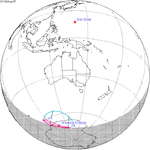 August 12, 1942 |
 May 30, 1946 |
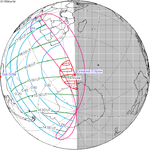 March 18, 1950 | |
| 121 | 123 | 125 | 127 | 129 |
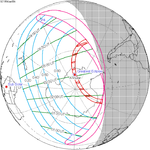 January 5, 1954 |
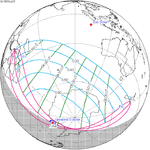 October 23, 1957 |
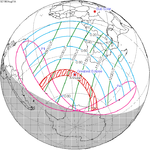 August 11, 1961 |
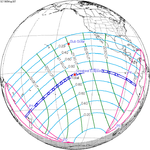 May 30, 1965 |
 March 18, 1969 |
| 131 | 133 | 135 | 137 | 139 |
 January 4, 1973 |
 October 23, 1976 |
 August 10, 1980 |
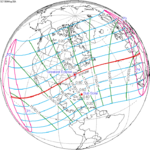 May 30, 1984 |
 March 18, 1988 |
| 141 | 143 | 145 | 147 | 149 |
 January 4, 1992 |
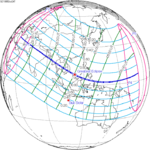 October 24, 1995 |
 August 11, 1999 |
 May 31, 2003 |
 March 19, 2007 |
| 151 | 153 | 155 | ||
 January 4, 2011 |
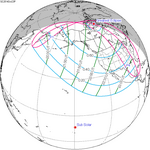 October 23, 2014 |
 August 11, 2018 | ||
Tritos series
[edit]This eclipse is a part of a tritos cycle, repeating at alternating nodes every 135 synodic months (≈ 3986.63 days, or 11 years minus 1 month). Their appearance and longitude are irregular due to a lack of synchronization with the anomalistic month (period of perigee), but groupings of 3 tritos cycles (≈ 33 years minus 3 months) come close (≈ 434.044 anomalistic months), so eclipses are similar in these groupings.
| Series members between 1801 and 2087 | ||||
|---|---|---|---|---|
 August 17, 1803 (Saros 132) |
 July 17, 1814 (Saros 133) |
 June 16, 1825 (Saros 134) |
 May 15, 1836 (Saros 135) |
 April 15, 1847 (Saros 136) |
 March 15, 1858 (Saros 137) |
 February 11, 1869 (Saros 138) |
 January 11, 1880 (Saros 139) |
 December 12, 1890 (Saros 140) |
 November 11, 1901 (Saros 141) |
 October 10, 1912 (Saros 142) |
 September 10, 1923 (Saros 143) |
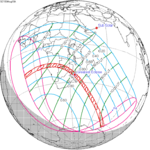 August 10, 1934 (Saros 144) |
 July 9, 1945 (Saros 145) |
 June 8, 1956 (Saros 146) |
 May 9, 1967 (Saros 147) |
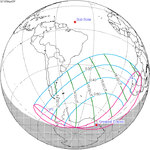 April 7, 1978 (Saros 148) |
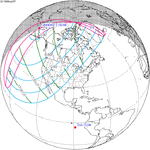 March 7, 1989 (Saros 149) |
 February 5, 2000 (Saros 150) |
 January 4, 2011 (Saros 151) |
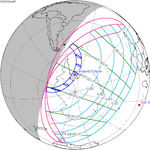 December 4, 2021 (Saros 152) |
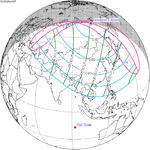 November 3, 2032 (Saros 153) |
 October 3, 2043 (Saros 154) |
 September 2, 2054 (Saros 155) |
 August 2, 2065 (Saros 156) |
 July 1, 2076 (Saros 157) |
 June 1, 2087 (Saros 158) | |||
Inex series
[edit]This eclipse is a part of the long period inex cycle, repeating at alternating nodes, every 358 synodic months (≈ 10,571.95 days, or 29 years minus 20 days). Their appearance and longitude are irregular due to a lack of synchronization with the anomalistic month (period of perigee). However, groupings of 3 inex cycles (≈ 87 years minus 2 months) comes close (≈ 1,151.02 anomalistic months), so eclipses are similar in these groupings.
| Series members between 1801 and 2200 | ||
|---|---|---|
 May 25, 1808 (Saros 144) |
 May 4, 1837 (Saros 145) |
 April 15, 1866 (Saros 146) |
 March 26, 1895 (Saros 147) |
 March 5, 1924 (Saros 148) |
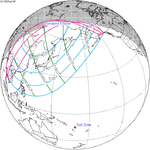 February 14, 1953 (Saros 149) |
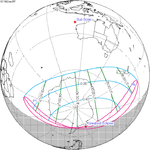 January 24, 1982 (Saros 150) |
 January 4, 2011 (Saros 151) |
 December 15, 2039 (Saros 152) |
 November 24, 2068 (Saros 153) |
 November 4, 2097 (Saros 154) |
 October 16, 2126 (Saros 155) |
 September 26, 2155 (Saros 156) |
 September 4, 2184 (Saros 157) |
|
Notes
[edit]- ^ "January 4, 2011 Partial Solar Eclipse". timeanddate. Retrieved 11 August 2024.
- ^ "Mideast, Europe catch partial eclipse". Sentinel Tribune. 2011-01-04. p. 3. Retrieved 2023-10-25 – via Newspapers.com.
- ^ "Years's 1st partial eclipse is today". The Daily Oklahoman. 2011-01-04. p. 7. Retrieved 2023-10-25 – via Newspapers.com.
- ^ Eclipses during 2011 NASA
- ^ "Partial Solar Eclipse of 2011 Jan 04". EclipseWise.com. Retrieved 11 August 2024.
- ^ van Gent, R.H. "Solar- and Lunar-Eclipse Predictions from Antiquity to the Present". A Catalogue of Eclipse Cycles. Utrecht University. Retrieved 6 October 2018.
- ^ "NASA - Catalog of Solar Eclipses of Saros 151". eclipse.gsfc.nasa.gov.
References
[edit]- Earth visibility chart and eclipse statistics Eclipse Predictions by Fred Espenak, NASA/GSFC
External links
[edit]- Live web-cast of the Partial Solar Eclipse of 2011 Jan 04 Archived 2010-12-31 at the Wayback Machine Bareket observatory, Israel
- Solar eclipse of 2011 January 4. Russia, Moscow. 4 Photos Archived 2019-08-14 at the Wayback Machine
- APOD 1/5/2011 [1], 1/6/2011 [2], 1/7/2011 [3]
- SpaceWeather.com Solar eclipse gallery On Jan. 4, 2011
- Solar Eclipse from spain


